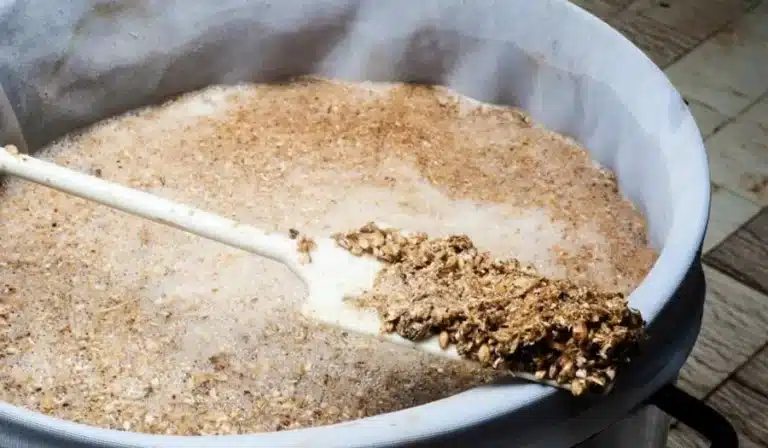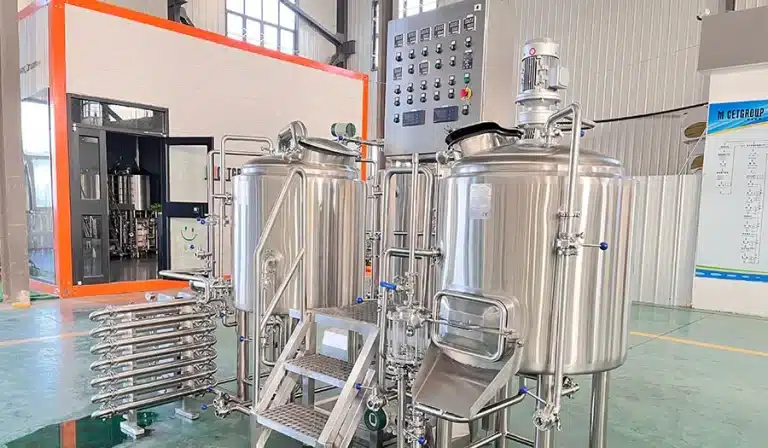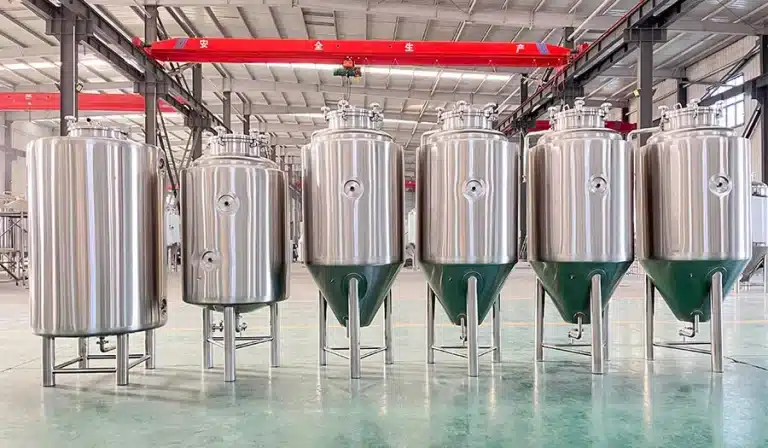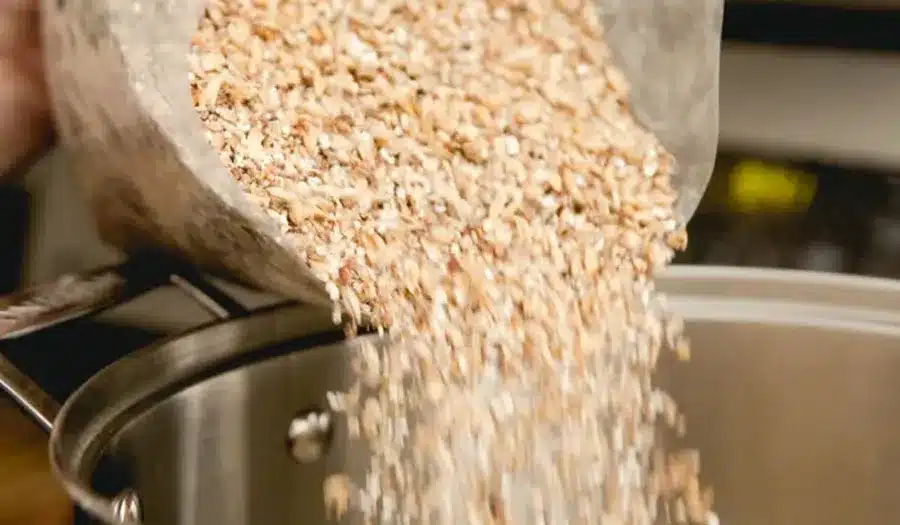Com o aumento da cultura da cerveja artesanal, cada vez mais amantes da cerveja estão a tentar fabricar cerveja em casa. Entre os muitos equipamentos de fabrico de cerveja, equipamento de fabrico de cerveja integral é a chave para conseguir uma produção de cerveja de alta qualidade. Em comparação com o método tradicional de fabrico de cerveja utilizando malte em pó, o fabrico de cerveja integral pode reter melhor o sabor natural do malte e proporcionar uma experiência de sabor mais rica e única à cerveja. Este artigo apresenta a composição, o princípio de funcionamento e as vantagens do equipamento de fabrico de cerveja integral.
O que é a produção de cerveja de cereais integrais?
A produção de cerveja de grão inteiro é um método de fabrico de cerveja que utiliza malte de grão inteiro (ou seja, "grão inteiro"). Ao contrário do método tradicional de fabrico de cerveja que utiliza malte em pó pré-tratado (ou concentrado de malte), o fabrico de cerveja de grão inteiro utiliza diretamente o grão de malte inteiro para a produção de cerveja. Depois de todo o grão de malte ser esmagado, é convertido em cerveja através de uma série de processos, tais como a mistura, a filtração, a fervura e a fermentação. Este método permite reter melhor o sabor natural e os nutrientes do malte, produzindo assim uma cerveja mais rica e com melhor sabor.

O processo de fabrico de cerveja integral
Malte inteiro
Na produção de cerveja integral, o malte integral é utilizado sem pré-tratamento. O malte integral contém todos os componentes do malte, incluindo a casca, o gérmen e o endosperma. Estes componentes podem conferir mais camadas de sabor à cerveja através da brassagem (conversão do amido do malte em açúcares fermentáveis) e de outros processos subsequentes.
Processo de brassagem
Na produção de cerveja integral, a brassagem é o passo mais crítico. O malte integral é misturado com água quente e as enzimas do malte convertem o amido em açúcares. Durante este processo, os fabricantes de cerveja podem controlar o efeito da brassagem ajustando a temperatura, o tempo e o valor do pH, o que determina o sabor, o corpo e a sensação na boca da cerveja.
Puré caseiro
No processo de fabrico de cerveja integral, todos os componentes do malte são utilizados, pelo que não é necessário comprar malte em pó adicional. Os fabricantes de cerveja precisam de moer os grãos de malte e depois misturá-los com água quente para formar um mosto (também conhecido como "papa"). Nesta etapa, os açúcares do malte são libertados e a etapa de fermentação subsequente converte estes açúcares em álcool.
Filtragem e ebulição
O líquido amassado (mosto) precisa de ser separado dos resíduos sólidos de malte. Este passo é normalmente efectuado numa cuba de filtração ou num filtro. Depois de filtrado, o mosto vai para uma chaleira para ferver, altura em que se adiciona o lúpulo para dar amargor e aroma e concentrar ainda mais o mosto.
Fermentação
Após a brassagem e a ebulição, o mosto tem de ser arrefecido a uma temperatura adequada e é adicionada levedura para fermentação. A levedura converte o açúcar do mosto em álcool, dióxido de carbono e vários compostos aromáticos para formar o corpo e o sabor da cerveja.
Composição do equipamento de fabrico de cerveja de grão inteiro
Máquina de moagem
A produção de cerveja a partir de cereais integrais requer, em primeiro lugar, a moagem do malte inteiro em partículas adequadas para a produção de cerveja, o que é efectuado por uma máquina de moagem. Existem normalmente dois tipos de máquinas de moagem: as máquinas de moagem de rolos e as máquinas de moagem de martelos. As máquinas de moagem de rolos podem moer o malte de forma mais homogénea e reduzir a quebra excessiva do malte, o que ajuda a melhorar o efeito do mosto.
Panela de trituração
Um pote de mosto é um dispositivo que mistura malte moído com água quente para converter o amido do malte em açúcar. O processo de brassagem requer um controlo rigoroso da temperatura e do tempo, e a gama de temperaturas comum é de 65°C a 75°C. A conceção do pote de mosto inclui normalmente um sistema de controlo da temperatura e um dispositivo de agitação para garantir que o processo de mosto é uniforme e atinge o efeito ideal de hidrólise enzimática.
Tina de Lauter (filtro de mosto)

Após a conclusão da brassagem, o malte e a mistura líquida (mosto) precisam de ser separados. A cuba de clarificação separa fisicamente o resíduo de malte do mosto para garantir que o mosto final é límpido. Este processo envolve normalmente uma fase de "papa" e uma fase de "lavagem", em que o malte é lavado repetidamente para maximizar a extração de açúcares fermentáveis no mosto.
Caldeira
Depois de filtrado, o mosto tem de ser fervido para matar as bactérias e concentrar o sabor. A caldeira também é utilizada para adicionar lúpulo, que pode libertar as substâncias amargas e os componentes aromáticos do lúpulo, acrescentando amargor e um sabor equilibrado à cerveja. O sistema de controlo da temperatura da caldeira assegura que o mosto atinge uma temperatura elevada durante o processo de ebulição, mantendo normalmente uma temperatura de 90°C a 100°C.
Refrigerador
O mosto fervido está a uma temperatura elevada e precisa de ser rapidamente arrefecido até à temperatura de fermentação (normalmente entre 18°C e 25°C). O arrefecedor reduz rapidamente a temperatura para um intervalo adequado à fermentação da levedura, trocando calor entre o mosto quente e a água fria ou gelada, evitando a morte da levedura devido à temperatura elevada ou à incapacidade de realizar uma fermentação óptima.
Fermentador
O fermentador é o local onde a levedura fermenta o mosto. Neste processo, a levedura converte o açúcar do mosto em álcool e dióxido de carbono para produzir cerveja. Os barris de fermentação estão normalmente equipados com válvulas de ventilação e dispositivos de controlo da temperatura para assegurar um controlo estável da temperatura durante o processo de fermentação, a fim de evitar a oxidação e a acumulação excessiva de dióxido de carbono.
Equipamento de engarrafamento (ou equipamento de barril)
Após a fermentação, a cerveja precisa de ser fermentada e clarificada. O equipamento de engarrafamento ou de barril ajuda a cerveja a entrar em garrafas ou barris para ser armazenada e consumida. Este processo envolve normalmente etapas como o arejamento e a adição de açúcar para garantir o sabor e o efeito de espuma da cerveja.
Vantagens da produção de cerveja com cereais integrais
- Retém o sabor natural do malte: Em comparação com o pó de malte pré-tratado tradicional, a produção de cerveja integral utiliza malte integral, pelo que pode reter ao máximo o aroma e o sabor naturais do malte. O malte integral pode libertar melhor os sabores doce, maltado, frutado e outros durante o processo de fabrico da massa, e a cerveja fabricada tem um sabor mais rico e camadas mais evidentes.
- Melhorar a flexibilidade e a capacidade de controlo da produção de cerveja: A utilização de cereais integrais permite aos fabricantes de cerveja controlar com precisão factores como a quantidade de malte utilizada, a temperatura da massa e o tempo, regulando assim o sabor e o estilo da cerveja. Esta flexibilidade permite aos fabricantes de cerveja personalizar a cerveja de acordo com os gostos pessoais e criar um sabor único.
- Maior eficiência na produção de cerveja: Durante o processo de fabrico de cerveja de cereais integrais, os fabricantes de cerveja podem otimizar a eficiência da extração de açúcar controlando o processo de fermentação e de mistura, aumentando assim a produção de álcool. Em comparação com a utilização de malte em pó pré-tratado, o fabrico de cerveja integral pode utilizar melhor os nutrientes do malte e aumentar a plenitude do corpo.
Como escolher o equipamento de fabrico de cerveja totalmente em grão?
Manual e automatizado
- Equipamento manual: adequado para cervejeiros com orçamentos limitados que gostam de trabalhar com as mãos e controlar o processo de fabrico da cerveja. O equipamento manual é geralmente mais económico, mas exige que os cervejeiros tenham certas competências e experiência para ajustar a temperatura do mosto, o tempo e outras operações.
- Equipamento automatizadoO equipamento automatizado pode controlar automaticamente a temperatura do mosto, a agitação, a filtragem e outros processos, o que é adequado para cervejeiros de grande escala ou cervejeiros que pretendam controlar com precisão o processo de fabrico de cerveja. O equipamento automatizado pode controlar automaticamente a temperatura do mosto, a agitação, a filtração e outros processos, o que é adequado para fabricantes de cerveja em grande escala ou fabricantes de cerveja que pretendam controlar com precisão o processo de fabrico de cerveja.
Capacidade do equipamento
Ao escolher o equipamento, é necessário ter em conta o volume de fabrico de cerveja. O processo de fabrico de cerveja de grão inteiro requer mais matérias-primas e tempo, pelo que, de acordo com as diferentes necessidades de fabrico de cerveja, pode escolher equipamento de diferentes capacidades:
- Equipamento pequeno: adequado para fabricantes de cerveja caseiros ou principiantes, geralmente com uma capacidade de 10 a 20 litros. O equipamento pequeno é fácil de controlar e adequado para os principiantes experimentarem e explorarem vários sabores.
- Equipamento de tamanho médio: adequado para cervejeiros com alguma experiência, geralmente com uma capacidade de 30 a 50 litros, que pode satisfazer necessidades mais elevadas de fabrico de cerveja.
- Equipamento de grandes dimensões: Adequado para os fabricantes de cerveja que pretendem efetuar uma produção comercial em pequena escala ou em lotes, com uma capacidade superior a 100 litros, o que pode proporcionar um maior rendimento e eficiência.

Limpeza e manutenção
A escolha de equipamento que seja fácil de limpar e manter é a chave para garantir uma utilização a longo prazo. Durante o processo de fabrico de cerveja de grão inteiro, o equipamento é propenso a acumular resíduos de malte, açúcares e levedura. Por conseguinte, a escolha de equipamento com um design fácil de limpar pode evitar a acumulação de sujidade e garantir a qualidade da produção de cerveja.
Orçamento e marca
Por último, ao escolher o equipamento de fabrico de cerveja, é necessário ponderá-lo de acordo com o seu orçamento. O equipamento topo de gama oferece normalmente mais funções de automatização e melhor precisão de controlo, mas o preço é mais elevado. O equipamento de nível básico é adequado para principiantes e é mais acessível. Se não souber como escolher, pode contactar o grupo micet. Os nossos engenheiros profissionais personalizarão o seu equipamento de fabrico de cerveja integral para si.
Resumo
A produção de cerveja de grão inteiro é um método de fabrico mais natural e complexo. Ao utilizar malte integral, não só retém mais sabor e nutrientes do malte, como também proporciona uma maior flexibilidade e controlo da produção. Embora este método de fabrico exija elevados requisitos técnicos, um grande investimento em equipamento e muito tempo, as vantagens em termos de sabor e paladar que proporciona são incomparáveis. Para os entusiastas do fabrico de cerveja que procuram uma cerveja artesanal de maior qualidade, o fabrico de cerveja totalmente em grão é também uma escolha ideal que vale a pena experimentar.




